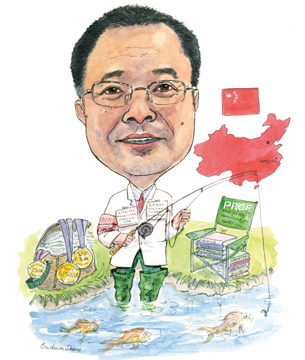
In the future, will interventional radiology be a subspecialty of radiology, or surgery? asks Gao-Jun Teng, professor of Radiology, Zhongda Hospital, Southeast University, Nanjing, China. Teng is a former president of the Chinese Society of Interventional Radiology (CSIR). CSIR will host the 13th Asia Pacific Society of Cardiovascular and Interventional Radiology (APSCVIR) meeting in Suzhou, China, in April 2016. As the president-elect of APSCVIR and Organising Committee chair, Teng extends a warm welcome to guests from all over the world for the meeting.
What drew you to medicine and interventional radiology?
In China, medical students are selected from high school graduates after an annual national examination. When China underwent the Cultural Revolution, the education system was destroyed and most universities stopped recruiting students. At this time, I was a middle school student and fortunately, the university education system then reverted to normal in 1977 and I entered medical school in 1979. My motivation for attending medical school was unclear at that point, perhaps I had no other options at the time! I did, however, have a distinct reason for choosing interventional radiology as my subspecialty in 1987 as I believed that interventional radiology represented the future of modern medicine.
Who were your mentors and what wisdom did they impart to you?
My first interventional radiology mentor was Prof Xi-Lei Cai. As a Master’s degree student in Radiological Science in Nanjing Railway Medical College, he taught me how to do research in interventional radiology as well as trained me as a general radiology resident. During this period, I came to Hangzhou to train under Prof Zhi-Jiang Liu, one of pioneers of interventional radiology in China, who made a tremendous contribution in the early years of interventional radiology in China. He trained many of the first generation interventional radiologists including Prof Linsun Li. Prof Liu has a very distinct personality in China, combining a rigorous approach to training physicians whilst at the same time caring for patients. He ardently loved interventional radiology and underwent interventional radiology procedures of percutaneous lumbar discectomy for lumbar disc herniation and transarterial bronchial arterial chemotherapy for lung cancer later in life. Although Prof Linsun Li was not my mentor, he still had a strong and positive impact on my career, as we worked together in different hospitals in the city of Nanjing. He has contributed to interventional radiology in China since the 1980s and he still works, even as he approaches 80.
What did you enjoy most about your fellowship at the Dartmouth-Hitchcock Centre in Lebanon, USA?
I was lucky to work as a research associate at Dartmouth-Hitchcock Centre from 1995 to 98, supervised by Dr Michael Bettmann. I was involved in several research projects, including the application of a new stent in transjugular intrahepatic portosystemic shunting (TIPS). In the animal study, we found that the TIPS shunt restenosed severely and quickly, which piqued my interest in investigating the mechanism. We then focused on the bile leakage during the TIPS and proved that bile leak is associated with the restenosis of TIPS shunt by prohibiting the endothelialisation of the TIPS stent instead of promoting the proliferation of smooth muscle cells. This research led to the publication of two papers published in Radiology. Our results indicated that a covered stent may be a reasonable means to decrease TIPS restenosis. I was also involved in a clinical study of TIPS patients which was published in American Journal of Roentgenology. Besides the research activities, I joined in many clinical seminars, workshops and case discussions with other residents and fellows.
As a recognised inventor, could you please describe the process of inventing the radiation stent loaded with 125I seeds for oesophageal cancer, biliary tract malignancies, and portal vein tumour thrombus? Why was this device necessary and important?
Oesophageal carcinoma in China is the fourth leading cause of death by cancer, which contributes to 48.9% of new cases worldwide (223,000/Year/China). Whilst it is ranked as the sixth most common cause of mortality in the world, most patients with oesophageal squamous-cell carcinoma are usually identified at the advanced stages of the disease, where only 15–20% of patients have a chance of successful surgical resection. When the cancer is unresectable, dysphagia is the main symptom. Unfortunately, many patients with advanced stage oesophageal cancer are only able to undergo palliative treatments to relieve dysphagia. Stent placement provides a rapid and effective palliation, but recurrence in the long-term is common. Brachytherapy takes longer to relieve the symptoms of dysphagia but provides longer patency and fewer complications compared with stent placement.
To combine the advantages of the immediate relief of oesophageal dysphagia by the use of stents with the longer-term benefits achieved through brachytherapy, a novel ooesophageal stent loaded with 125I seeds has been developed by our team of interventional radiologists in my department and engineers in Nanjing Micro-Tech Co Ltd. The technical feasibility and safety of this new stent have been reported in healthy rabbits (Eur J Radiol 2007; 61: 356–61). Results from a single-centre randomised controlled clinical trial with 27 patients in the radiation stent group vs. 26 patients in the control group showed a remarkable difference in mean survival (8.3 months for the 125I stents and 3.5 months for the conventional stents) (Radiology 2008; 247: 574–81).To confirm the outcomes of this novel stent, a multicentre, randomised phase III trial was performed. From 1 November 2009–1 July 2012, 170 patients from 16 hospitals in China were entered into the trial. Ten patients refused to participate. We randomly assigned 160 patients to either receive the 125I stent or the control stent. The results showed a significant difference in median survival (177 days in the 125I stent group vs. 147 days in the conventional stent group), and a more sustained relief from dysphagia in the 125I stent group, especially in those patients who survived for long periods. No increased complications related to radiation therapy occurred. The major results of this trial were published in Lancet Oncology 2014;15(6):612-9.
Please describe a memorable case that you treated…
One of the most memorable cases I treated was a 51-year-old female patient who underwent percutaneous vertebroplasty as she had been misdiagnosed as having metastatic lesions rather than lumbar tuberculosis after presenting with aggressive back pain for four months. After a CT, MRI and ECT were taken and metastasis in L3 vertebral body was diagnosed due to her breast cancer history, she was referred to our department for vertebroplasty due to unrelieved back pain after radiation therapy. Immediately after the vertebroplasty procedure, the patient complained of aggravated back pain. The lumbar tuberculosis was finally established after our team carried out many examinations, including a laboratory test, radiological examination, and a percutaneous biopsy after the vertebroplasty procedure. The patient experienced aggravated back pain with a reduced quality of life following the vertebroplasty procedure for three months until surgical debridement and instrumentation was applied. The reason why I chose her as a memorable case is because it was unforgettable for us, the treating physicians and the patient, who underwent great and persistent suffering for three months following the misdiagnosis and wrong treatment.
You have been a strong advocate for interventional radiology to be a more clinical specialty. Currently, over 70% of interventional radiology departments in China have the interventional radiology own dedicated inpatient wards, and many of them have merged other specialties such as vascular surgery. Your own department has become “Department of interventional radiology and Vascular Surgery” with 86 inpatient beds currently. What are the positive aspects and challenges of admitting your own patients?
The reason for running our own inpatient wards is just for survival; the situation is similar to that seen in the West. Interventional radiology in China has been in a turf battle with many other specialties such as vascular surgery, cardiology, neurosurgery, and neurology, since 1990. From these battles, we have realised that the best form of defense is to attack. We believe we should be recognised as full clinicians, as the surgeons are, and have our own interventional outpatient clinics, inpatient wards and follow-up clinics. In 1998, I set up an interventional radiology inpatient ward with six beds. By 2007, a Department of Interventional Radiology and Vascular Surgery had been established and we currently have 86 beds. The positive aspects are obvious; this makes self-referral possible and interventional radiology is independent from other specialties. There is also recognition from our patients and the media. The biggest challenge for such a model is our ability to recruit radiologists who have the correct background. We have recruited other specialists, such as vascular surgeons, general surgeons and hepatologists into our team.
As a former president of the Chinese Society of interventional radiology (2009-2011), could you please briefly describe the status of interventional radiology in China?
Interventional radiology is widely recognised by other medical societies and the media in China. Interventional radiology has become a hot specialty that many young residents in diagnostic radiology, as well as other specialties apply for. Interventional radiology only started in the 1980s with the open policy after the Cultural Revolution. It has developed rapidly and there are now currently more than 5,000 full-time interventional radiologists with around 50,000 inpatient beds throughout the country. Two months ago an association of interventional physicians was founded, which is a national society that includes interventional radiologists, cardiologists, vascular surgeons and neurosurgeons. Prof Ke Xu, an interventional radiologist, was selected as the first president and I was selected as its first vice president. Many pioneers of interventional radiology contributed to the achievements of interventional radiology in China today, I am not old enough to be considered as a pioneer of interventional radiology, but I contributed to pushing for interventional radiology to be recognised as a full clinical specialty when I was president of the CSIR.
What are the biggest questions in interventional radiology that you would like to see answered?
My first question would be, what is the future of interventional radiology? Will it be a subspecialty of radiology, a subspecialty of surgery, or an independent specialty? Secondly, what is the exact definition of interventional radiology? Interventional radiology differs from other minimally invasive techniques due to the use of imaging-guidance. What about combination with other therapeutic techniques such as endoscopy? Should interventional radiologists perform hybrid procedures?
What are the most interesting technological developments in interventional radiology that are likely to impact patient care in China?
Transarterial chemoembolization and tumour ablation for liver cancer are the number one procedures in terms of interventional radiology volumes. I would like to see any new developments in this field, because these interventional radiology techniques will have a real impact on the care of patients with liver cancer.
What are your interests outside of medicine?
Fishing is my favourite entertainment when on vacation and it always gives me a unique and memorable experience.
Fact File
Current appointments
2012– Dean, Medical School, Southeast University
1998– Professor of Radiology, chair, Department of Radiology and director, Center of Interventional Radiology and Vascular Surgery, Zhong-Da Hospital, Southeast University
Professional experience
1995–98 Dartmouth Medical School, Hanover, USA Research associate in Vascular and Interventional Radiology
1993–95 Associate professor of Radiology, Nanjing Railway Medical College, Nanjing, China
1989–93 Assistant Professor of Radiology, Nanjing Railway Medical College, Nanjing, China
1990–95
Chief, Vascular & Interventional Radiology Division, Nanjing Railway Medical College, Nanjing, China
Education and training
2000–03 PhD in Radiological Science, Shanghai Medical School, Fudan University, Shanghai, China
1986–89 MS in Radiology, Nanjing Railway Medical College, Nanjing, China
Societies
2012–14 Vice-president, Chinese Society of Radiology (CSR)
2009–11 President, Chinese Society of Interventional Radiology (CSIR)
2008– Fellow of Society of Interventional Radiology (SIR)
2013– Fellow of Cardiovascular and Interventional Radiological Society of Europe (CIRSE)
2014–16 President-elect, Asian-Pacific Society of Cardiovascular & Interventional Radiology (APSCVIR)
Journals
2008– Editor, Cardiovascular and Interventional Radiology (CVIR)
2009– Editor-in-chief, Journal of Interventional Radiology (Chinese)
2005– Editorial Committee Member, Chinese Journal of Medicine
1997– Editorial Committee Member, Chinese Journal of Radiology
Awards
2011 National Scientific and Technological Achievement Award, China









